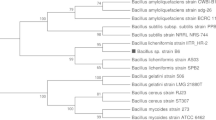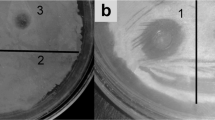Abstract
The study of the extracellular bacteriolytic enzymes of Lysobacter sp. showed that they can efficiently hydrolyze the peptidoglycan of gram-positive bacteria provided that there is an electrostatic interaction of these enzymes with the cell wall anionic polymers, teichoic and teichuronic acids in particular. The hydrolytic action of bacteriolytic enzymes on the cell wall largely depends on the negative charge of the teichoic and teichuronic acids rather than on their chemical composition.
Similar content being viewed by others
REFERENCES
Stepnaya, O.A., Ledova, L.A., and Kulaev, I.S., Bacteriolytic enzymes, Usp. Biol. Khim., 1999, vol. 39, pp. 327–354.
Shockman, G.D. and Holtje, J.-V., Microbial Peptidoglycan (Murein) Hydrolases, Bacterial Cell Wall, Ghuysen, J.-M. and Hakenbeck, R., Eds., Amsterdam: Elsevier Science BV, 1994, pp. 131–166.
Sitkin, B.V., Lysanskaya, V.Ya., Tsfasman, I.M., and Stepnaya, O.A., The Structure of Peptidoglycan from Lysobacter sp., a Producer of Extracellular Bacteriolytic Enzymes, Mikrobiologiya, 2003, vol. 72, pp. 136–137.
Stepnaya, O.A., Begunova, E.A., Tsfasman, I.M., and Kulaev, I.S., The Bacteriolytic Enzyme Preparation Lysoamidase: Purification and Some Physicochemical Properties of Extracellular Muramidase from Xanthomonas sp., Biokhimiya, 1996, vol. 61, no. 4, pp. 648–655.
Stepnaya, O.A., Begunova, E.A., Tsfasman, I.M., and Kulaev, I.S., The Bacteriolytic Enzyme Preparation Lysoamidase: Purification and Some Properties of Bacteriolytic L1 Peptidase, Biokhimiya, 1996, vol. 61, no. 4, pp. 656–663.
Stepnaya, O.A., Severin, A.I., and Kulaev, I.S., Some Physicochemical Properties of Lytic L2 Proteinase Isolated from the Enzyme Complex Lysoamidase of a Bacterium from the Family Pseudomonadaceae, Biokhimiya, 1986, vol. 51, pp. 909–915.
Stepnaya, O.A., Ledova, L.A., and Kulaev, I.S., The Bacteriolytic Enzyme Preparation Lysoamidase: The Interaction Nature of Constituting Enzymes and Polysaccharide, Biokhimiya, 1993, vol. 58, pp. 1523–1528.
RF Patent no. 2193063.
White, D., The Physiology and Biochemistry of Prokaryotes, New York: Oxford Univ. Press, 1995.
Pooley, H.M., Abellan, F.-X., and Karamata, D., Cell Wall Teichoic Acid, Peptidoglycan Synthesis and Morphogenesis in Bacillus subtilis, Bacterial Growth and Lysis, de Pedro, M.A. et al., Eds., New York: Plenum, 1994, pp. 385–392.
Holtje, G.V. and Tomasz, A., Specific Recognition of Choline Residues in the Cell Wall Teichoic Acid by the N-Acetylmuramyl-L-Alanine Amidase of Pneumococcus, </del>J. Biol. Chem., 1975, vol. 250, pp. 6072–6076.
Podvin, L., Reysst, G., Hubert, J., and Sebald, M., Presence of Choline in Teichoic Acid of Clostridium acetobutylicum, J. Gen. Microbiol., 1988, vol. 134, no. 6, pp. 1603–1609.
Tomasz, A., Biological Consequence of the Replacement of Choline by Ethanolamine in the Cell Wall of Pneumococcus: Chain Formation, Loss of Transformability, and Loss Autolysis, Proc. Natl. Acad. Sci. USA, 1968, vol. 59, no. 1, pp. 86–92.
Lindsay, B. and Glaser, L., Characterization of the NAcetylmuramic Acid L-Alanine Amidase from Bacillus subtilis, J. Bacteriol., 1976, vol. 127, no. 2, pp. 803–811.
Tempest, D.W., Dicks, J.W., and Elwood, D.C., Influence of Growth Condition on the Concentration of Potassium in Bacillus subtilis var. niger and Its Possible Relationship to Cellular Ribonucleic Acid, Teichoic Acid and Teichuronic Acid, Biochem. J., 1968, vol. 106, pp. 237–243.
Shaw, D., Mirelman, D., Chatterjee, N.N., and Park, J.T.,Ribitolteichoic Acid Synthesis in Bacteriophage-Resistant Mutants of Staphylococcus aureus H, J. Mol. Biol., 1970, vol. 245, no. 19, pp. 5101–5106.
Schleifer, K.N. and Kandler, O., Peptidoglycan Types of Bacterial Cell Walls and Their Taxonomic Implications, Bacteriol. Rev., 1972, vol. 36, pp. 407–477.
Streshinskaya G.M., Naumova I.B., Panina L.I. The Chemical Composition of the Cell Wall of Streptomyces chrysomallus Producing the Antibiotic Aurantin, Mikrobiologiya, 1979, vol. 48, pp. 814–818.
Rogers, H.J., Perkins, H.R., and Ward, J.B., Structure of Peptidoglycan, Microbial Cell Walls and Membranes, London: Chapman and Hall, 1980, pp. 190–214.
Naumova, I.B. and Shashkov, A.S., The Cell Wall Anionic Polymers of Gram-Positive Bacteria, Biokhimiya, 1997, vol. 62, no. 8, pp. 947–982.
Rights and permissions
About this article
Cite this article
Stepnaya, O.A., Begunova, E.A., Tsfasman, I.M. et al. The Mechanism of Action of the Extracellular Bacteriolytic Enzymes of Lysobacter sp. on Gram-Positive Bacteria: The Role of the Cell Wall Anionic Polymers of Target Bacteria. Microbiology 73, 404–409 (2004). https://doi.org/10.1023/B:MICI.0000036984.97267.4e
Issue Date:
DOI: https://doi.org/10.1023/B:MICI.0000036984.97267.4e




